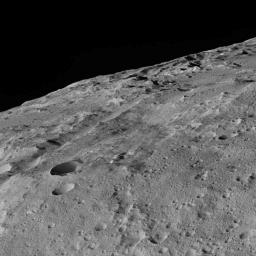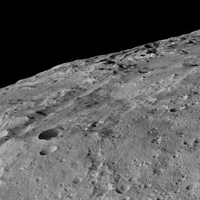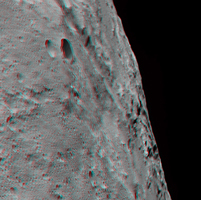
|
Dawn LAMO View Around Gerber Catena, Ceres
- Click the image above for a larger view
- Full-Res JPEG (1024 x 1024) (136.4 kB)
- Full-Res TIFF (1024 x 1024) (848.8 kB)
Caption:
|
Click on an individual image for larger view
These views of Ceres, taken by NASA's Dawn spacecraft on December 10, shows an area in the southern mid-latitudes of the dwarf planet. They are located at approximately 38.1 south latitude, 209.7 east longitude, around a crater chain called Gerber Catena.
Many of the troughs and grooves on Ceres were likely formed as a result of impacts, but some appear to be tectonic, reflecting internal stresses that broke the crust.
A slightly different view of the same area, taken in the same sequence (Figure 1), is also available. The two views were combined to make a 3-D anaglyph (Figure 2).
The spacecraft took these images in its low-altitude mapping orbit (LAMO) from an approximate distance of 240 miles (385 kilometers) from Ceres.
Background Info:
Dawn's mission is managed by JPL for NASA's Science Mission Directorate in Washington. Dawn is a project of the directorate's Discovery Program, managed by NASA's Marshall Space Flight Center in Huntsville, Alabama. UCLA is responsible for overall Dawn mission science. Orbital ATK, Inc., in Dulles, Virginia, designed and built the spacecraft. The German Aerospace Center, the Max Planck Institute for Solar System Research, the Italian Space Agency and the Italian National Astrophysical Institute are international partners on the mission team. For a complete list of acknowledgments, see http://dawn.jpl.nasa.gov/mission .
For more information about the Dawn mission, visit http://dawn.jpl.nasa.gov .
Cataloging Keywords:
| Name | Value | Additional Values |
|---|---|---|
| Target | 1 Ceres | |
| System | Main Belt | |
| Target Type | Dwarf Planet | Asteroid |
| Mission | Dawn | |
| Instrument Host | Dawn | |
| Host Type | Orbiter | |
| Instrument | Framing Camera (FC) | |
| Detector | ||
| Extra Keywords | Crater, Grayscale, Impact | |
| Acquisition Date | ||
| Release Date | 2015-12-22 | |
| Date in Caption | ||
| Image Credit | NASA/JPL-Caltech/UCLA/MPS/DLR/IDA | |
| Source | photojournal.jpl.nasa.gov/catalog/PIA20186 | |
| Identifier | PIA20186 | |


